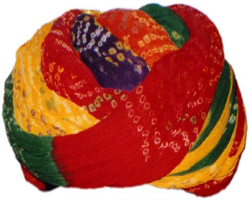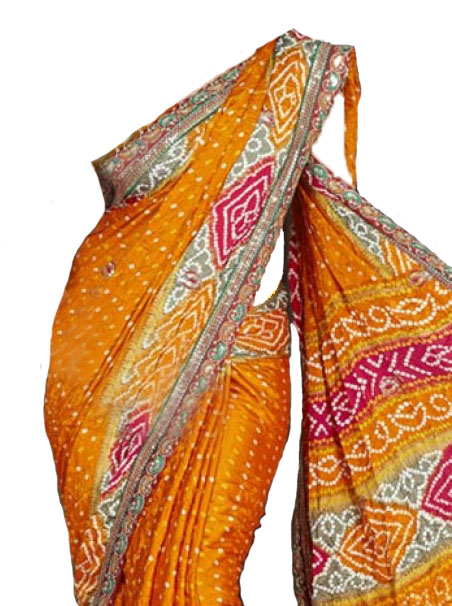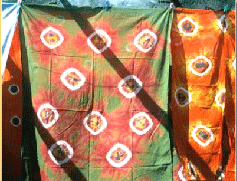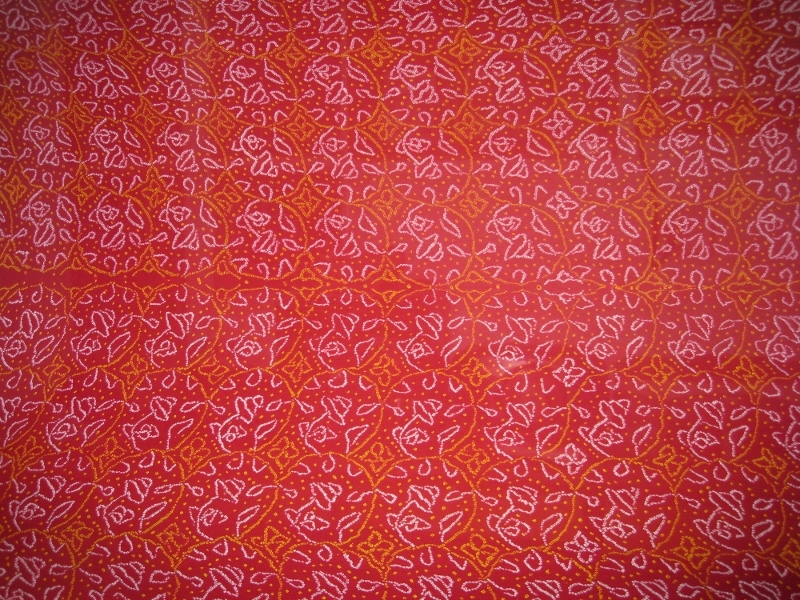
- home
- Bandhani
- region
- raw material
- popular dyes for bandhani
- designs
- process of bandhani
- change in bandhani
 Bandhani Turban
Bandhani Turban
Dyed Textile-Designs
 The red and yellow odhani called piliya, from pila, yellow, or pomcha, from padma or pom, lotus, when it has a stylised flower in the centre, is probably the most frequently seen garment in Rajasthan. In its most basic form, the piliya has red border and a yellow field with a quincunx pattern of a large red circle in the centre and four smaller ones surrounding it. This basic pattern is usually decorated with a design of tie-dyed white dots within the medallions and border, and the whole piece may be further embellished by sewing on flat gold ribbon or sprinkling with metallic dust. This process is done by first stamping a pattern in a paste mixture on to the fabric, scattering the 'gold' dust over the textile and gently brushing off the residue for re-use. Fine cotton odhani with an all-over pattern of colored
The red and yellow odhani called piliya, from pila, yellow, or pomcha, from padma or pom, lotus, when it has a stylised flower in the centre, is probably the most frequently seen garment in Rajasthan. In its most basic form, the piliya has red border and a yellow field with a quincunx pattern of a large red circle in the centre and four smaller ones surrounding it. This basic pattern is usually decorated with a design of tie-dyed white dots within the medallions and border, and the whole piece may be further embellished by sewing on flat gold ribbon or sprinkling with metallic dust. This process is done by first stamping a pattern in a paste mixture on to the fabric, scattering the 'gold' dust over the textile and gently brushing off the residue for re-use. Fine cotton odhani with an all-over pattern of colored  diamond shapes, called laddu(after the sweet of the same name) or dabbi, a small box are also in demand. Often edged with silver or gold ribbon, these cloths are made in a wide variety of colors, including Rajasthani dove-grey, with diamonds in red, green and white, but traditional red or yellow field remain the most popular.
diamond shapes, called laddu(after the sweet of the same name) or dabbi, a small box are also in demand. Often edged with silver or gold ribbon, these cloths are made in a wide variety of colors, including Rajasthani dove-grey, with diamonds in red, green and white, but traditional red or yellow field remain the most popular.
Shikari bandhni

The depiction of human and animal figures in dazzling colours is the characteristics of Shikari bandhni.
The Ekdali
The Ekdali pattern flaunts small circles and squares in different shades and the cluster of three, four and seven multi-coloured dots make it even more gorgeous.
Sambar Lehar and Phagun
This designs is worn especially during the spring season.
Dungar-shahi
The mountain-pattern, boond which results in a small dot with a dark centre
Kodi
tear shaped Bandhani.
Laddu-jalebi
Tikunthi